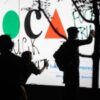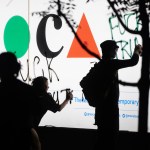As a student in the Art & Social Justice class at Cal State Fullerton, Jasmine Solei had the opportunity to visit the California Institute for Women in Chino, where she and other students led art workshops for incarcerated women.
Taught by Mary Anna Pomonis, assistant professor in the Department of Visual Arts, the Art & Social Justice course tasks students with creating lesson plans centered around social justice and then teaching those courses in alternative venues to groups outside the university.
Solei was leaving the prison after the first workshop during the Spring 2023 semester and was struck by the sight of a children’s playground boxed in behind barbed-wired fences situated adjacent to the visitation area.
As a mother herself, Solei thought about her own son, Kayden, who was 2 years old at the time.
“I just thought to myself that I can’t even imagine what it would be like to have to go through that, not only as the parent but as the child to have to visit your parent behind bars,” Solei said. “And it dawned upon me that there are parents in here that are separated from their kids.”
This manner of interaction between parents and their children ignited a spark of inspiration in Solei, who went on to create a more expansive art program using art as a medium for incarcerated women to bond with their children and family members.
Solei recently completed a series of monthly art workshops inside the women’s prison in Chino in which the inmates and their children got to create artwork together.
She titled the program: “Creative Healing for Forgotten Families.”
“Every time, we’ve had a great turnout at the prison,” Soleil said. “There’s always been lots of kids and families, so I’ve been able to bring arts and crafts to them.”
When the workshop was completed, Solei curated an exhibition featuring the artwork titled “Caged Voices: Artistic Reflections on Mass Incarceration.”
The exhibition is currently on display on the fourth floor of the Pollak Library.
“The work itself is some of the most rewarding stuff I’ve ever done in my life,” Solei said. “I absolutely love it, and I would love to continue on with this work for as long as I can.”
Before moving forward with her project, Solei received a $15,000 scholarship from the Donald A. Strauss Public Service Scholarship Foundation.
Established as a memorial to the late Don Strauss of Newport Beach, the foundation annually awards the scholarships to 15 California college sophomores and juniors for projects involving service to the community.
Solei was the first Cal State Fullerton student to be recognized as a Strauss Scholar.
After reading her student’s proposal, Pomonis encouraged Solei to apply for the scholarship.
“This is the first proposal I read that was a meaningful attempt for a student to explore what they could do for a mom who was in a situation where they weren’t able to spend time with their kids, except in this really strange environment,” Pomonis said. “So, by making the visiting room the site of creativity, it makes everybody relax more and the visit better.”
Solei was also motivated to launch her workshops after becoming aware of some telling statistics related to children of incarcerated parents.
Research conducted by the nonprofit Prison Policy Initiative showed that nearly half of the approximately 1.25 million people in state prisons are parents of minor children, with about one in five of those children age 4 or younger.
According to the National Institute of Justice, an agency within the U.S. Department of Justice, family members of incarcerated individuals are often thought of as “hidden victims” who “receive little personal support and do not benefit from the systemic societal mechanisms generally available to direct crime victims, despite their prevalence and their similarities to direct crime victims.”
Pomonis and Solei also formed a campus group titled Just Arts, which enables them to partner with other campus and community groups in bringing art workshops into prisons.
Those include Project Rebound, a program assisting formerly incarcerated individuals wanting to attend college.
CSUF is among several Cal State universities with a Project Rebound chapter.
Solei, incidentally, also earned a grant from the city of Santa Ana, enabling her to teach art to underserved populations in the city.
She also works part time conducting healing arts classes as part of an outpatient mental health program.
Her ultimate goal is to earn a degree that would enable her to become an art therapist.
“I think sometimes we push people to take classes for credit, which is great, and you should do that, but you should know why you’re wanting to take those classes for credit,” Pomonis said. “A lot of it is getting to know yourself and your heart and how to express yourself more effectively. And the arts do that.”
This post was originally published on this site be sure to check out more of their content.









